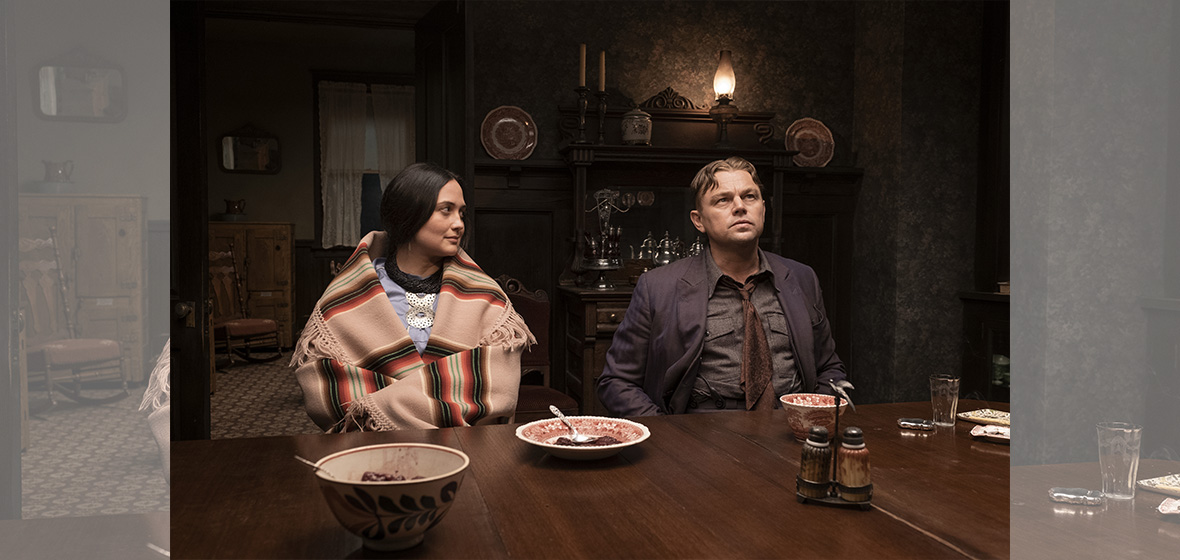Scorsese’s relationship with religion, especially Catholicism, and America is complex and fascinating. A good part of his 26 (and counting) features is dedicated to highlighting the corrupting nature of the inhumanity that built that country. The other part is a way for Scorsese to reckon with his own cultural and religious upbringing. Scorsese makes films about the complex relationship between the self and organised spirituality and how the American experience is violent and oppressive, but we can do nothing to stop it.
Killers of the Flower Moon starts with an Osage ceremony. Religion, hand-in-hand with culture, is the foundation of community. There is reverence and respect in Scorsese’s camerawork, portraying the Native American nation with the same familiarity that he films Portuguese Catholic missionaries.
In the 1920s, the Osage were, per capita, the wealthiest community in the United States because of the oil boom. One member shows a sea of rigs in the prairie, like abhorrent giants that take over a peaceful land, while he acutely notes this progress is fickle. One day, the oil will disappear, and the land will be worth nothing.
At the centre of the plot, Mollie (Lily Gladstone), a wealthy Osage woman, is concerned about a series of murders and disappearances in her community that the authorities turned a blind eye to. Wealth not only corrupts, it also attracts corruption, which in this case comes from an invasion of white businessmen and good-for-nothing scroungers fighting for their piece of the pie. One is William Hale (Robert De Niro), a businessman who earned the respect of the Osage, and his nephew Ernest (Leonardo DiCaprio), who sees a chance to court and later marry Mollie.
As more Osage die and land deeds end up in the hands of white people, Mollie makes one last plea to the American government, which sends Tom White (Jesse Plemmons) from the newly-formed Federal Bureau of Investigation. There is no hiding who the murderer is; at this point of the story, Scorsese wants its audience to bear witness to every crime perpetrated, powerless but aware of the implications. He is grabbing our heads and forcing us to look at where white American privilege comes from.
Scorsese positions the camera like he’s filming a Great American Epic, with sweeping wide shots and wide depth of field to make it look grandiose. At the same time, Thelma Schoonmaker, Scorsese’s longest collaborator who has edited every one of his films, structures each scene with pulsating intensity, violent and brutal. Like Scorsese and Schoonmaker, they use the visual language of the classic American epic and repurpose it to show how the country’s pioneering spirit grows in selfishness.
Di Caprio is the weakest link in the film. He struggles to hold the intensity through the film’s three-and-a-half hour runtime. But when he hits his stride, Ernest perfectly represents the privileged side of the bumbling buffoon. However, De Niro is tremendous, adding so much nuance to his character that it almost becomes morally questionable to make Hale so sympathetic.
But it’s Gladstone that runs with all the accolades. It’s like Scorsese made the film for her only. Her character is relegated to the background momentarily, and I yearned to see her on the screen again. Tragic and powerful, Gladstone embodies a whole century of First Nations misrepresentation in cinema in her performance.
Killers of the Flower Moon is a film about how America continually destroys because it is in its nature. Twice, it references the massacre of Tulsa, where a group of white supremacists destroyed a whole block of successful African-American businesses, killed more than 30 people and injured over 800. The film goes out of its way to remind us of the injustice suffered by minorities in America when they play and win the same game as the rest of the people. The difference is that it does so not to wallow in the guilt of what happened, but as a stark reminder of the cruelty surrounding us. Scorsese does not want to fix the issue, but he wants us to contemplate it.
A couple of days ago, one of the Osage consultants, Christopher Cote, was interviewed on the film’s red carpet. In it, he expressed how happy and thankful he was for the film, but he didn’t believe it had been made for the Osage audience. And he’s right. For all the efforts to heighten their voice (the original book by David Grann is centred on the FBI investigation, whereas the film introduces the Bureau two hours into the runtime), Killers of the Flower Moon is not a film about a wronged culture that didn’t get wiped out because of its perseverance. It’s a film about those who chose to forget the slaughter. Even flawed, it remains a masterpiece.
Verdict: 5 out of 5
For everyone who thinks this new Scorsese era, including Silence and The Irishman, includes some of the most thematically cohesive films the director has ever done.




